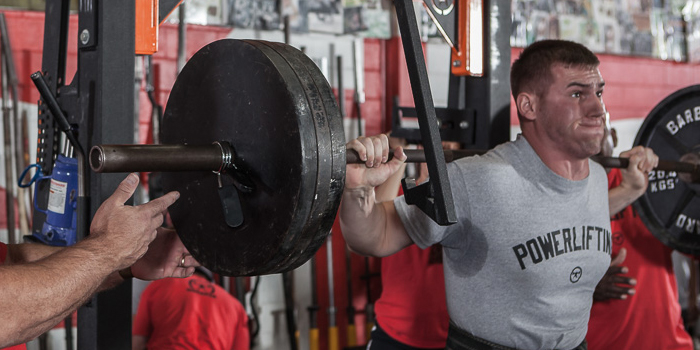
After one of the craziest springs in modern history, many Americans are moving into the summer and looking forward to the fall with hopes of transitioning back into a lifestyle that looks and feels a lot more normal. Sports make up an incredibly large component of our way of life, and for many, these hopes for normal could be realized by simply being able to participate, watch, and attend their favorite sporting event.
As many states begin to reopen, sports teams across all levels are beginning to return to salvage what is left of summer sports or off-season training. From an off-season training perspective, football finds itself in a unique situation as it approaches the fall.
Proper off-season preparation for the football athlete is highly dependent on the time spent in the late spring and early summer. Football is a high impact sport that subjects the body to a large amount of force– and that's before we start talking about hitting or tackling. Being able to stabilize, absorb, and create the acceleration and deceleration forces involved in football require adaptation in soft tissues, bone, and the nervous system. Simply put, if you are waiting until the summer to begin preparing for the fall, you're already behind the eight ball–and coaches across the nation are well aware of this.
RECENT: Are Athletics Healthy for You?
So if you're a coach or athlete feeling the uncertainty of fall sports and pressure of starting the offseason late in 2020, here are some dos and don'ts for approaching training over the next few months.
Dos
DO Mix Strength, Agility, Skill Work, and Conditioning into your Training
This is especially important initially in training. Even if you have had your athletes doing offseason workouts on their own, there is still a lot of unknown as far as the level of intensity and execution of these workouts. Furthermore, if you run block periodization, this point is going to be an even bigger key component.
Football demands performance in a multitude of attributes. Speed, strength, power, cardiovascular fitness, and the ability to accelerate and decelerate are a few that come to mind. If you just lost four months in your offseason that are usually dedicated to bringing up specific attributes individually, you're going to have to build all these attributes together during the short offseason. To do this, consider using a conjugate approach. There are many conjugate training programs that are specific to football on elitefts.
Training economy is another huge reason to mesh multiple attributes into each training session. Among the numerous challenges facing teams right now is simply limits on the amounts of players that can train at one time together. That means small and numerous training groups. To combat this, consider using stations for each attribute that you are wanting to train.
For example, your first training group may start with strength work. When that station is finished, Group 1 can move on to skills and drills, and Group 2 can begin strength training. As Group 2 finishes strength work, they move into skills and drills, while Group 1 starts into a conditioning finisher, and Group 3 starts into strength training. This continues until all groups are cycled through and allows for more work to be done by more athletes. If you need 45 minutes of strength training but only 25 minutes of skill work and 20 minutes for conditioning, consider combining stations.
DO Shorten Training Times
Using the above example of funneling your athletes through stations, I am not talking about having a two-and-a-half hour-long training session. More than ever, training needs to focus on quality, not quantity. If you throw too much at your athletes, their performance will decrease, and they will get hurt.
Hard times often bring out the best in us, because it forces us to prioritize, adapt, and overcome more barriers than we are used to. The necessity of quality over quantity will challenge coaches to analyze their training programs and ask the question, "Why are we doing this?" If there is not a clear answer to that question or the answer is repetitive (i.e., something else in training is already answering that question), that is an indicator that the task or movement in question may need to go. Now more than ever, you have to pick movements, drills, or activities that have a high return for the time invested.
DO Pay Attention to the Mood of Your Players
One of the best ways to determine the readiness of an athlete for training is simply by paying attention to their nonverbals. Coaches spend a lot of time around their players. That means they should know the personality and characteristics of their athletes. Some are more outgoing, others more reserved. Some will run through a wall for you, whereas others need motivation.
This can serve to your advantage in ensuring that your athletes are recovering well and are ready to train. Overtraining takes a toll on the body in more ways than one. If overtrained, your athletes will stop sleeping as well, their resting heart rate will rise, and their nervous system will start to shift into a sympathetic dominant state of fight, flight, or freeze.
On the surface level, these physiological changes can noticeably manifest in your players–if you're paying attention. Individually, your athletes may look sluggish or lowly motivated. Perhaps they look stiff while warming up or take more warm-up sets before their working weights in the weight room. They also can appear more tired and have a hard time concentrating. You may notice a complete change in mood from outgoing to reserved in your more outgoing athletes/leaders, or you may notice irritability in your athletes. In isolation, considering one athlete for one day, may not be a big enough tip. But if you start seeing these changes in multiple athletes at a time, that should be a yellow flag to start asking the question, "Why?"
As a team, indicators are broad, but often more noticeable. As a coach, pay attention to the atmosphere before training and during warm-ups. What do you see? What do you hear? Is your team loose, chatty, and playfully interacting with each other, or are they tight, quiet, and distanced? These are huge indicators of the readiness of your athletes. Another great way to gauge the readiness of your team is to ASK, "How do you guys feel?" The more you ask and build a relationship with your players (especially at the high school level), the more honesty you'll get out of them on what's going on with their bodies.
Don't
Don't Play Catch Up
If the game is tied at halftime, you wouldn't freak out about getting back into the game in the second half, right? The same goes here. Everyone got dropped into halftime of the offseason, and the score is 0-0. The point is, this situation is a level playing field. Is this ideal? No. Do we all wish we had more time to train our athletes? Yes, but those who end up trying to play catch up with their offseason schedules from last year are going to be in trouble. Their athletes will be more fatigued and likely injured before the season even gets started.
The 2020 narrative for football will be different than most seasons. Being prepared for the 2020 season will not meet the same requirements of the years before it. Rather, being prepared will highly depend on a coach not beating their athletes into the ground and keeping them as healthy as possible with the little preparation time that is left.
Already in June, there are a lot of players with bony and tendinous injuries like shin splints and patellar pain. This is directly due to overloading the athlete with workloads that their body is not ready to handle. A team that runs into these problems during the offseason and at the start of the season are going to be in an uphill battle from the beginning and will struggle to find success.
DON'T Overlook the Value of this Season
There are a lot of unknowns and discomfort with the upcoming fall season. A lot of coaches and players will look at the offseason and whatever comes of the season, whether it be a shortened schedule, reduced fan base, etc., and be tempted to call it a wash or place an asterisk next to the outcome of the season.
"We would have had a great team if we'd had the necessary time to prepare."
"We could have made a playoff run, but our guys fatigued later in the season because we couldn't train them like we wanted to."
"X school district got to start training when our district held us back an extra two weeks."
"Next year, when we can have enough time to prepare, we will have a better season."
For some programs, the excuses will go on and on as to why their season didn't go as planned. The reality is that 2020 will have an asterisk next to it. Everyone will have an asterisk for 2020 that signifies what that year meant to them. It's the perception of what the asterisk stands for that will determine the value you give the 2020 season.
RELATED: Extra Workouts for the Off-Season Football Player
To me, 2020 will be about one theme and one theme only–resilience. As Flight Director Gene Krantz famously interjects in Apollo 13 to the statement of the Apollo 13 mission being the greatest disaster in NASA history, "With all due respect, I think this will be our finest hour."
Resilience will determine the winners and losers of 2020, whether it be on the football field, in the industrial sector, in your community, and even within your family. The winners of 2020 will be those who didn't back down, who did things right, and who looked for opportunity within the constraints and restrictions of 2020. The teams who recognize that this year is different from all other years and adapt and train accordingly will be the teams that learn to be resilient and will have success in 2020.
After all, the game of football (not to mention the game of life) is full of setbacks, hardships, and restrictions. Those who recognize it for what it is, adapt, and push through will be victorious. If you approach your asterisk in that regard, there has never been a more important year than 2020.










